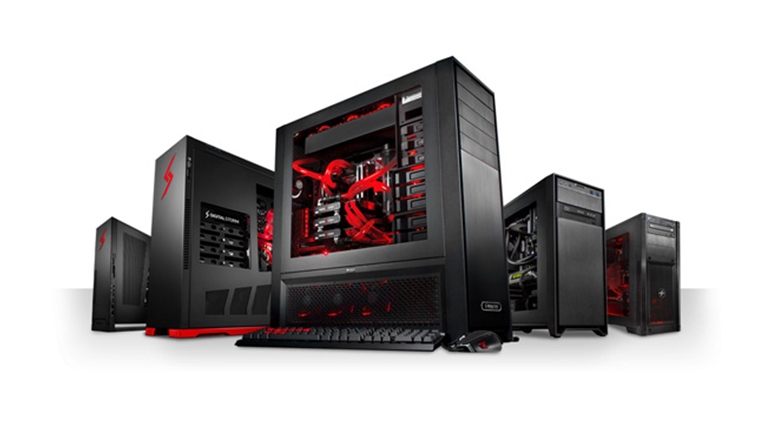Virtual reality has come a long way in recent years, as an increasing number of creative individuals and companies have started producing brilliant content for the platform.
There was a time when a serious VR title was hard to find.
Today, however, numerous fantasy worlds have sprung up across all the major VR platforms.
This activity has convinced a lot of gamers to get into VR gaming.
Perhaps the biggest question that may come to your mind when you’ve decided to buy a VR gaming setup is, “Will my computer be able to handle VR?”
VR-Ready Computer Hardware
In your quest to answer the aforementioned question, you must have stumbled upon the term “VR-Ready”.
VR-ready hardware means that the tagged hardware is compatible with VR applications.
Does that mean that a graphics card without the “VR-ready” stamp on its package doesn’t support VR? Not at all.
It’s basically just a term used better to promote PC hardware.
You won’t require some special hardware to run VR on your PC.
However, you do need serious processing and graphics power to support VR games.
Why Do You Need a Powerful PC?
Compared to monitor display rendering, VR rendering is much more intense.
The main reason for that is that the top-tier headsets have a rendering resolution of at least 2560 x 1200 pixels.
Most gaming monitors usually feature 1080p resolution.
Moreover, top-tier VR headsets require at least a 90 fps framerate; not having this threshold results in a stuttering display, which will make your VR experience very uncomfortable.
In this article, we will discuss the officially-recommended VR specifications, and alternative techniques to check if your PC can compute VR for top-tier VR headsets like the HTC Vive, the Oculus Quest, and the Windows Mixed Reality VR headsets.
The Oculus Rift
The Oculus Rift is Oculus’ flagship tethered VR headset, and is one of the best VR gaming headsets in the industry.
The Oculus Rift’s recommended VR specifications are listed below:
- Graphics Card: NVIDIA GTX 1060, or AMD Radeon RX 480
- Alternative Graphics Card: NVIDIA GTX 970, or AMD Radeon R9 290
- CPU: Intel i5-4590, or AMD Ryzen 5 1500X
- Memory: 8 GB RAM
- Video Output: Compatible HDMI 1.3 video output
- OS: Windows 10
If your PC configuration meets or exceeds this list of specifications, you can enjoy the Oculus Rift’s content library without any worries.
Alternatively, you can use Oculus’ official VR compatibility checker tool. The Oculus Compatibility Check Tool is a simple and user-friendly application which assesses your computer’s configurations, and tells you whether or not you can use the Oculus Rift with your PC.
The Oculus Compatibility Check Tool also shows a list of your PC’s hardware that can’t support VR.
You can use that list to upgrade your PC.
The HTC Vive / Valve / SteamVR
HTC’s flagship VR headset, the HTC Vive, is another best in class VR headset which is comparable in quality to the Oculus Rift.
The HTC Vive supports the Valve’s SteamVR platform, which has an extensive library of VR experiences and intensive VR game titles.
We’ve listed the HTC Vive Pro’s officially-recommended VR specifications below:
- Graphics Card: NVIDIA GeForce GTX 1060, or AMD Radeon RX 480
- Processor: Intel Core i5-4590, or AMD FX 8350
- Memory: 4 GB RAM
- Video Output: HDMI 1.4 or DisplayPort 1.2 or higher
- USB: USB 3.0 port
- OS: Windows 8.1, Windows 10
If your PC configuration meets or exceeds the above-listed specifications, then you can enjoy the best VR content that the HTC Vive and SteamVR have in store.
Keep in mind that the HTC Vive and HTC Vive Pro mostly have the same recommended specs.
An HDMI 1.4 port, instead of a DisplayPort 1.2, and a USB 2.0 port, instead of a USB 3.0, wouldn’t diminish your experience much.
You can also check the VR compatibility of your computer using the SteamVR Performance Test application.
This one-click application by SteamVR will take mere moments to evaluate your PC configuration, and show you the capability of your computer to support VR.
The application shows the result on a scale comprised of three values: Not Ready, Capable, and Ready; Ready means that your PC exceeds the minimum requirements for VR computing.
Windows “Mixed Reality” VR
Microsoft’s Windows Mixed Reality is a platform that enables both of the cutting-edge technologies: Virtual reality, and augmented reality.
Microsoft has developed a pretty sleek platform that has a lot of interesting VR content.
Here are Microsoft’s official recommended specifications for Windows Mixed Reality VR:
- Graphics Card: NVIDIA GTX 1060 DX12-capable discrete GPU, or AMD RX 470/570 DX12-capable discrete GPU, or better
- Graphics Driver: Windows Display Driver Model (WDDM) 2.2
- Display: Connected external or integrated VGA (800 x 600) display, or better
- Graphics Display Port: HDMI 2.0, or DisplayPort 1.2
- Processor: Intel Core i5 4590 (4th Generation), or AMD Ryzen 5 1400 3.4GHz, or better
- RAM: 8GB DDR3, or better
- Free Disk Space: At least 10 GB
- Operating System: Windows 10 Fall Creators Update (RS3) – Home, Business, Education. (Not supported on N versions, or Windows 10 Pro S Mode)
- USB Connectivity: USB 3.0 Type-A or Type-C
- Bluetooth Connectivity (for motion controllers): Bluetooth 4.0
- Expected Headset Framerate: 90 fps
Alternatively, you can use the Windows Mixed Reality PC Check application to benchmark your PC, and find out if it supports VR gaming.
Why Not Go Standalone with the Oculus Quest?
I wouldn’t be surprised if a few of you don’t have a powerful PC, and can’t afford expensive hardware right now.
If that is the case, I would highly recommend the all-new standalone VR headset, the Oculus Quest.
The Oculus Quest is among the best top-tier standalone VR headsets, and costs only $399.
The Oculus Quest doesn’t require any other equipment (like a powerful computer) to give you great VR experiences.
The standalone VR headset is fully capable of 6 DOF inside-out tracking, without the need for setting up external sensors around the room.
Oculus will start shipping the Oculus Quest in the spring of 2019. B
y that time, according to Mark Zuckerberg, at least 50 awesome VR titles will be available in the standalone VR headset’s content library.




